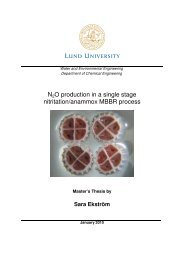Alexander Szabo and Oscar Engle - Svenskt Vatten
Alexander Szabo and Oscar Engle - Svenskt Vatten
Alexander Szabo and Oscar Engle - Svenskt Vatten
You also want an ePaper? Increase the reach of your titles
YUMPU automatically turns print PDFs into web optimized ePapers that Google loves.
Facultative Ponds<br />
The main features of the facultative ponds are that they are horizontally divided into two layers,<br />
with <strong>and</strong> without oxygen presence. In the top layer (down to 20 - 30 centimeters of depth)<br />
photosynthesis makes micro-algae produce oxygen during daytime, the oxygen is then used by<br />
aerobic bacteria to degrade organic substrate. Some of the oxygen in the top layer has its origin<br />
from surface mass transfer, but it has been estimated that more than 80% of the oxygen is<br />
produced by algae (Shilton et al., 2005). The depth of oxygen presence in the water is changing<br />
<strong>and</strong> depends on many factors such as sunlight, water turbidity <strong>and</strong> organic loading (Shilton et al.,<br />
2005). In the bottom of the pond, no dissolved oxygen is available, which gives anaerobic<br />
bacteria opportunities to degrade substrate. The retention time of facultative ponds is relatively<br />
large, up to several weeks. The long retention time <strong>and</strong> the shallow design, typically depth is 1.5<br />
meters, make the ponds consume relatively large l<strong>and</strong> areas (Mara, 2003).<br />
Since the light needed for the algae arrives through the surface, facultative ponds are usually<br />
designed by surface loading. In temperate climates, algae are more productive in terms of oxygen<br />
production <strong>and</strong> the pond may therefore receive a higher loading of BOD. Eq. 2.1 (Mara, 2003) is<br />
used to calculate the maximum possible BOD loading per area:<br />
λ = 350∗(rtial-mix system (EPA, 2002). Since the aeration in a complete mix pond keeps large<br />
quantities of suspended solids mixed in the pond, a following post-settling pond should be<br />
installed. Partial-mix aeration may be installed into an existing facultative pond to improve the<br />
overall treatment efficiency.<br />
2.4 Degradation processes<br />
<br />
Removal of pollutants in Waste water treatment ponds<br />
The nature is capable to degrade human waste water when it is released into waterways. Problems<br />
occur when the load on our natural environment is bigger than the self-cleansing mechanisms<br />
available in our lakes <strong>and</strong> rivers. The more populated the world becomes, the higher the stress on<br />
our environment. The waste water treatment ponds are cleaning the water using the same<br />
processes as in nature. The task of the waste water treatment ponds is to optimize <strong>and</strong> isolate the<br />
processes, so that the cleaning has been done before the water is released in our waterways. In<br />
nature several processes are responsible for the treatment of polluted water, <strong>and</strong> these processes<br />
should be used <strong>and</strong> optimized as much as possible. Some of nature’s processes will be discussed<br />
in this section.<br />
Aerobic degradation<br />
When oxygen is present in water, aerobic microorganisms will use oxygen to oxidize organic<br />
compounds <strong>and</strong> produce carbon dioxide (CO 2 ), water <strong>and</strong> biomass (sludge). Since oxygen is<br />
consumed by the degradation, the process will be limited by the presence of oxygen. If large<br />
quantities of organic material are to be degraded, large amounts of oxygen must be supported. In<br />
<br />
18















